Mary Hoffman's Blog, page 15
March 29, 2012
Bologna Book Fair 2012 Day One

Well, I'm back from my 12th Bologna Book Fair, a bit the worse for wear, having brought home a chest infection along with all my catalogues, lists, notes and business cards.
A good Bologna begins on the plane out from Gatwick. Stuffed with editors, rights managers and agents, the 2pm flight is always a happy "spot-whom-you-know" event. Of course it shouldn't have been a surprise to see agent Catherine Clarke getting off the same coach from Oxford as me and we shared the long walk to the Terminal (when WILL they stop digging up that forecourt?).
Just long enough for her to tell me about Riversingers by Tom Moorhouse. "It's about water violes," Catherine told me. "A sort of Wind in the Willows for the 21st century."
Amanda Wood and Helen Boyle from Templar were fuelling up in Garfunkels like me and my travelling companion, self-described "Fair virgin" Lucy Coats. I even bumped into my own editor, Emma Matthewson (Bloomsbury) before getting on the plane.
We had a mad dash to the Random House party on the Sunday night with time only for one (the first of many) glass of prosecco. Then to dinner at old favourite Trattoria del Rosso and a satisfying chat about the novel that Lucy's agent would be selling at the Fair.
Monday morning brought that famous sight pictured above, the entrance to the Fair, followed by the annual grab for lanyards to put one's Fair pass in. I had no appointments till 11am so plenty of time to visit the Press Office and pick up my Catalogue, which acts as a Bible to the children's book world for a whole year.
Hall 25 feels like a second home to me now. I know where to expect Walker, Bloomsbury, Orion, Frances Lincoln to be and there they are. Also Nosy Crow. But this year sees a huge new stand for Bonnier.
 Templar are in there somewhere and the brand new hot property that is Hot Key. HK is headed up by Sarah Odedina, former Children's Publisher at Bloomsbury in the Harry Potter era. More of them in another post.
Templar are in there somewhere and the brand new hot property that is Hot Key. HK is headed up by Sarah Odedina, former Children's Publisher at Bloomsbury in the Harry Potter era. More of them in another post. My first port of call is usually Frances Lincoln, where they let me leave bags and coat. They have been doing absolute wonders with my Great Big Book of Families and its sequel, Feelings. I think we are up to 16 foreign editions on the first and the second is going well.
Hot properties this year are novels Amnesia by Savita Kalhan, At Yellow Lake by Jane McLoughlin and Keren David's new book about Ty, called Another Life.
I called in at the SCBWI stand (Society of Children's Book Writers and Illustrators) where Anita Loughrey was preparing for a very British afternoon:
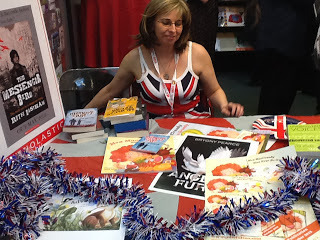
Earlier there I had met Sarah Towie, a genuine American in Paris, who has developed an exciting App about the French Revolution. It is narrated by Charlotte Corday ("Three days ago I killed a man")
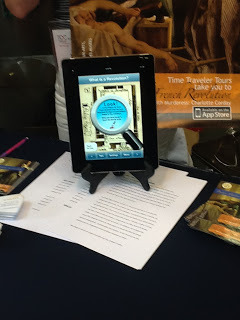
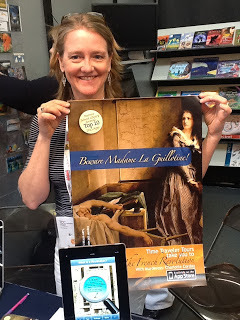
So you see the Fair is not just about books. One publisher with a new look was Barrington Stoke. A few years back they slightly lost their way, overpublishing at seventy titles a year. Now they have a new logo, a squirrel, a new slogan, "Cracking reading" and have reduced to forty titles. Here are Sales and Marketing Director Jane Walker, Managing Director Mairi Kidd and "Snuggs" the squirrel, named after Bounce distributor Robert Snuggs.
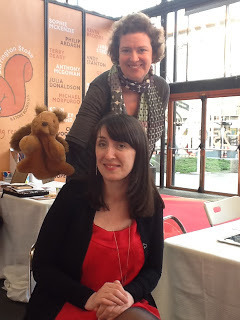
Barrington Stoke have always tempted top authors into writing for dyslexics and reluctant readers and next year Geraldine McCaughrean will join them. They are now publishing more titles for girls, even some in the US, called Stoke Books. "We're more 'tradey' these days, " says Jane Walker, "with titles being part of Waterstones Core Stock."
More tomorrow but I'm leaving you with one of my favourite stands at the Fair:

It belong to the Sharjah International Book Fair.
Published on March 29, 2012 09:07
March 15, 2012
A visit from Celia Rees
It's a great pleasure to welcome Celia Rees to my blog, as part of her extended tour talking about her new book, This is not Forgiveness (Bloomsbury). Not only because she has written extremely flattering stuff about me but because she is an old friend who has written a really good and interesting book!
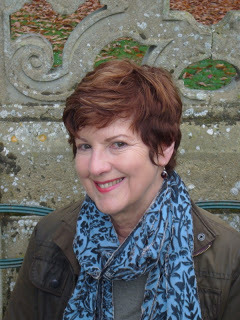 Photo by Terry Rees
Photo by Terry Rees
I love this picture of Celia, which shows that wicked glint in her eye that usually means mischief. There is trouble - big trouble - in her new book but it is a departure from her recent novels for Bloomsbury, which have been very successful historical fiction - Witch Child, Sorceress, Pirates, Sovay and The Fool's Girl. What a roll call of invention!
This is not Forgiveness is set in a now so up to date it makes your teeth hurt. It features a soldier with Post Traumatic Stress Disorder, a politically active girl with some very self-destructive tendencies and a boy who you just know is going to get caught up between them and suffer.
A bit about Celia:
Celia Rees was born and brought up in Solihull, in the West Midlands. She used some of her childhood for inspiration, directly in Truth or Dare and The Bailey Game, less obviously in her other books, although her love of pirates would eventually surface, and an adolescent reading of Bram Stoker's Dracula led to Blood Sinister.
She studied History and Politics at Warwick University, and was particularly interested in American History, something that one day would influence Witch Child and Sorceress. Celia was a teacher for over ten years, teaching English in Coventry secondary schools, before she began to write. Teaching provided plenty of inspiration and reasons for writing, and eventually she began to write with her students. Celia says, "That's when I knew what I wanted to do. I would write for teenagers, books that they would want to read, almost adult in style and content, but with people like them at the centre."
Now over to her:
Never underestimate the Book Maven. She is very clever and has many talents. Among them is her ability as a proof reader. She has a forensic attention to detail, knows the correct word for everything, her spelling is perfect, and her knowledge of all things grammatical is second to none. I trust her above all others. She especially loves finding things that the copy editor has missed, so when I got the first proof copies of This Is Not Forgiveness, I asked her to read it for me. I knew that if there were mistakes there, she'd find them.
There were not all that many mistakes, I was gratified to know, and the ones she found were fiendishly well spotted, but what really impressed me was that she had correctly identified the inspirational source for the novel. Unlike the Book Maven herself (see her previous post), I can usually point to a moment of inspiration and this book came to me while I was watching François Truffaut's film, Jules et Jim. It must have been late June, 2009. The film is a favourite of mine and I was watching it after returning from a week's holiday in Paris, trying to extend the magic. The film was made in 1962 and is set before and after the First World War, but the story is essentially timeless.
Two young men who are close friends fall for the same extraordinary girl, played by the wonderful Jeanne Moreau. The character she plays is unpredictable, exciting, and dangerous. Irresistible. The film is often light-filled and joyous but the underlying tension between the characters introduces a dark foreshadowing, a tenebrous note of foreboding, a feeling that this will not turn out well. As I was watching, I remember thinking: 'You could update this. Make it now.'
I couldn't begin straight away – I was busy writing another novel, The Fool's Girl, so my J & J Project had to wait. I can't write two things at once. What I can do, however, is a bit of research. I discovered that François Truffaut based the film on a novel by fellow French writer, Henri-Pierre Roché. The novel was out of print; Truffaut found it in a secondhand bookshop. The serendipitous nature of that discovery further intrigued me and seemed to confirm that this would be a good thing to do. I got hold of Truffaut's screenplay, then Roche's novel (thank goodness for AbeBooks). The screenplay is very close to the book and I particularly liked the voiceover. I would have loved to write my book in the same terse, elliptical style as Roché's novel but didn't think the Y.A. market was quite ready for that. I discovered that the novel was semi autobiographical: an account of the love triangle between Roche, the artist Marcel Duchamp, and American artist, Beatrice Wood. Or maybe between Roché, Franz Hessel and Helen Grund – Roché seems to have put himself about a bit. All fascinating stuff and certainly material for a historical novel set in the Paris of the period, peopled by writers and artists. Think of the research opportunities…
But no, that would be too adult. Anyway, I'd decided that this book was going to be contemporary. So I took what I needed from Jules et Jim: the characters, the relationship between them and the seeds of destruction that lies within it, and changed everything else.
Not many people have spotted the original inspiration, so respect is due.
Well, Celia has done nothing to spare my blushes. But Jules et Jim is one of my all time favourite films and I too own the original novel and the screenplay so perhaps it wasn't surprising that I made the connection. (Oh and I did have an EP - remember those? - of the music from the film).
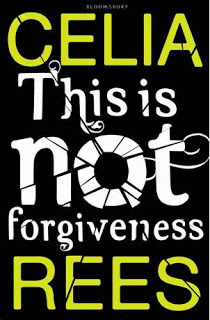
We have five copies of Celia's new book to give away to those who give the most interesting answers to this question:
What film has most lingered in your mind, perhaps giving you an idea for something you would like to write yourself?
Leave answers in the comments section below and you have till 24th March.
 Photo by Terry Rees
Photo by Terry ReesI love this picture of Celia, which shows that wicked glint in her eye that usually means mischief. There is trouble - big trouble - in her new book but it is a departure from her recent novels for Bloomsbury, which have been very successful historical fiction - Witch Child, Sorceress, Pirates, Sovay and The Fool's Girl. What a roll call of invention!
This is not Forgiveness is set in a now so up to date it makes your teeth hurt. It features a soldier with Post Traumatic Stress Disorder, a politically active girl with some very self-destructive tendencies and a boy who you just know is going to get caught up between them and suffer.
A bit about Celia:
Celia Rees was born and brought up in Solihull, in the West Midlands. She used some of her childhood for inspiration, directly in Truth or Dare and The Bailey Game, less obviously in her other books, although her love of pirates would eventually surface, and an adolescent reading of Bram Stoker's Dracula led to Blood Sinister.
She studied History and Politics at Warwick University, and was particularly interested in American History, something that one day would influence Witch Child and Sorceress. Celia was a teacher for over ten years, teaching English in Coventry secondary schools, before she began to write. Teaching provided plenty of inspiration and reasons for writing, and eventually she began to write with her students. Celia says, "That's when I knew what I wanted to do. I would write for teenagers, books that they would want to read, almost adult in style and content, but with people like them at the centre."
Now over to her:
Never underestimate the Book Maven. She is very clever and has many talents. Among them is her ability as a proof reader. She has a forensic attention to detail, knows the correct word for everything, her spelling is perfect, and her knowledge of all things grammatical is second to none. I trust her above all others. She especially loves finding things that the copy editor has missed, so when I got the first proof copies of This Is Not Forgiveness, I asked her to read it for me. I knew that if there were mistakes there, she'd find them.
There were not all that many mistakes, I was gratified to know, and the ones she found were fiendishly well spotted, but what really impressed me was that she had correctly identified the inspirational source for the novel. Unlike the Book Maven herself (see her previous post), I can usually point to a moment of inspiration and this book came to me while I was watching François Truffaut's film, Jules et Jim. It must have been late June, 2009. The film is a favourite of mine and I was watching it after returning from a week's holiday in Paris, trying to extend the magic. The film was made in 1962 and is set before and after the First World War, but the story is essentially timeless.
Two young men who are close friends fall for the same extraordinary girl, played by the wonderful Jeanne Moreau. The character she plays is unpredictable, exciting, and dangerous. Irresistible. The film is often light-filled and joyous but the underlying tension between the characters introduces a dark foreshadowing, a tenebrous note of foreboding, a feeling that this will not turn out well. As I was watching, I remember thinking: 'You could update this. Make it now.'
I couldn't begin straight away – I was busy writing another novel, The Fool's Girl, so my J & J Project had to wait. I can't write two things at once. What I can do, however, is a bit of research. I discovered that François Truffaut based the film on a novel by fellow French writer, Henri-Pierre Roché. The novel was out of print; Truffaut found it in a secondhand bookshop. The serendipitous nature of that discovery further intrigued me and seemed to confirm that this would be a good thing to do. I got hold of Truffaut's screenplay, then Roche's novel (thank goodness for AbeBooks). The screenplay is very close to the book and I particularly liked the voiceover. I would have loved to write my book in the same terse, elliptical style as Roché's novel but didn't think the Y.A. market was quite ready for that. I discovered that the novel was semi autobiographical: an account of the love triangle between Roche, the artist Marcel Duchamp, and American artist, Beatrice Wood. Or maybe between Roché, Franz Hessel and Helen Grund – Roché seems to have put himself about a bit. All fascinating stuff and certainly material for a historical novel set in the Paris of the period, peopled by writers and artists. Think of the research opportunities…
But no, that would be too adult. Anyway, I'd decided that this book was going to be contemporary. So I took what I needed from Jules et Jim: the characters, the relationship between them and the seeds of destruction that lies within it, and changed everything else.
Not many people have spotted the original inspiration, so respect is due.
Well, Celia has done nothing to spare my blushes. But Jules et Jim is one of my all time favourite films and I too own the original novel and the screenplay so perhaps it wasn't surprising that I made the connection. (Oh and I did have an EP - remember those? - of the music from the film).

We have five copies of Celia's new book to give away to those who give the most interesting answers to this question:
What film has most lingered in your mind, perhaps giving you an idea for something you would like to write yourself?
Leave answers in the comments section below and you have till 24th March.
Published on March 15, 2012 01:01
March 6, 2012
All the things that aren't writing
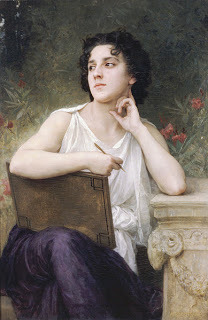 Inspiration (William-Adolphe Bouguereau)There used to be a popular feature in one of the Sunday glossies called A Day in the Life, or something like that. Whenever it was a writer, it went something like this:
Inspiration (William-Adolphe Bouguereau)There used to be a popular feature in one of the Sunday glossies called A Day in the Life, or something like that. Whenever it was a writer, it went something like this:5am Get up and write for two hours
7am Walk the dog
8am Breakfast with wife [big clue there]
9am -1pm Write
1pm Lunch with wife [ditto]
2-6pm Write
6pm Gin and Tonic
7pm Dinner with wife [get the picture?]
8-10pm Listen to opera
Sadly, this is the image that many non-writers have of those who do what I do. Quite apart from the fact that I never get up at 5am and have no dog or wife, I do wonder when these 10-hour-a-day novelists (usually novelists) ever did all the other things that aren't writing. Let me list some of them, in the rough chronological order of the life of a book - all except the actual writing:
Quiet thinking time
Researching (expands to fill available time)
Writing proposals or synopses and sample chapters
Re-writing and self-editing until the book or sample is fit to send
Dealing with publisher's edits [these may go back and forth]
Dealing with copy-edits [ditto]
Looking at and commenting on illustration roughs [only applies to children's writers]
" " " " " layouts (ditto)
Looking at book jacket visuals
Writing or editing/approving cover copy
Reading and checking proofs [often more than one round]
(Suggesting scenario for book trailer - optional)
Taking part in a Blog Tour [anything from one or two pieces written up to a month's worth] - increasingly not optional
Promoting book by book-signing tour, Festivals, Press interviews, school visits [children's writers]
Social networking on Facebook, Twitter etc.
(Reading reviews - optional)
Answering readers' letters and emails.
All that is for one book and if you write several a year, this work on them will overlap.

Then in general if you are writer with an interest in the industry, there will be these things, many of which are optional:
Conferences
Attending Festivals as part of audience
Book Fairs (London, Frankfurt, Bologna)
Reviewing other writers' books
Sitting on book prize committees
Maintaining your own blog (at least once a week) - increasingly expected by publishers
Guesting on other people's blogs
(Being part of a joint blog - optional)
Keeping your website updated
(Making up-to-date PowerPoints for presentations)
e-mailing agent, editor, PR person and dealing with their queries
Reading other books in your field to keep up
Putting in expenses claims
(Teaching creative writing courses/acting as RLF Fellow etc)
And the things that everyone does, especially freelances who work for themselves:
Keeping accounts up to date
Issuing invoices to Festivals, newspapers, (schools) etc.
(VAT quarterly if registered)
Tax returns
Tax payments twice yearly
Of course if you are wealthy or have a wealthy partner, you won't need to do all those things and there will also be some you can delegate to others, whom you pay to do them. But a day that is a mosaic or patchwork of several of the above is much more common than the 10 hours a day exclusively devoted to the actual business of writing, especially if you are a woman.
Inspiration
The lovely painting above shows a woman waiting for inspiration. The most common question questions asked of writers are "Where do you get your ideas from?" or "What inspired you to ...?" It has always baffled me. Why would you take on such an arduous, precarious and ill-paid career as writing if you were not simply teeming with an inexhaustible swarm of ideas begging to be turned into books?
The majority of my friends are published writers, people who make a living from writing books and though I have heard them talk about many aspects of their lives from money to research, agents to RSI, I have never once heard one of them use the word "inspiration."
What we all want more of is time, time to concentrate on "just writing" and that's why writers' retreats are so popular. You go somewhere remote and rural, without a phone signal, and divest yourself of all the things that aren't writing. You even have surrogate wives to cook for you. But it costs; it's a rare treat.

#amwriting
This is a Twitter hashtag developed by highly-motivated American writer Johanna Harness (@johannaharness). She has made a website for it too Every day on Twitter Johanna asks, "Are you writing?" or "What are you writing?" and using that hashtag, writers reply. So often I have to modify it to #amediting or #amrewriting or #amthinkingaboutmybook. Johanna kindly says it all counts and it does.
But it doesn't look always look like writing.
Published on March 06, 2012 21:08
February 28, 2012
Stroppy & Crabbit, Tomatoes and Tight Briefs

Once a year in February, the SAS gathers in a secret location to exchange tips on how to storm bastions, rescue colleagues and generally improve chances of world domination. The location is so secret that, although this year it was held near Peterborough, it was referred to in code as "Coventry."
Don't let that deceive you into thinking that meant no-one could be talked to. On the contrary, There were people there like "Stroppy Author" and "Crabbit old bat", so code-named after their blogs, who were much talked to and about; I even saw them talking to each other. It was obviously top secret stuff, since I heard the word "agent" said a few times. There's also a rumour that the Crabbit one has been awarded some sort of medal for outstanding service and grace under fire.
Stroppy & Crabbit sound like lawyers but don't be deceived; still, you'd always want them on your side. (There was a lawyer there - one who knew something about pirates).
I'm not allowed to show you the one photo I managed to take between sessions, meals and quaffing. But I can show you a picture of me with my camera, which sort of proves I was there, wherever there was.
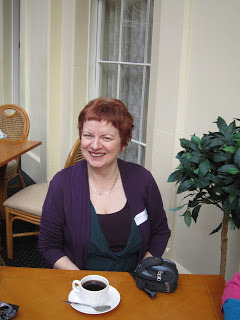 Photo by Keren DavidI also have a cup of coffee, which is one reason I have taken off my balaclava and am looking so happy. But in the interests of fairness, I've told you that Keren David was there too, because she took the photo. (Clearly that's a pseudonym).
Photo by Keren DavidI also have a cup of coffee, which is one reason I have taken off my balaclava and am looking so happy. But in the interests of fairness, I've told you that Keren David was there too, because she took the photo. (Clearly that's a pseudonym).There was also a veteran from the SAS's very beginning - a founder member - who talked darkly of murder notebooks and dead time. And the Scribble Central Citizen, who had been taming beasts in America and feeding beastly pirates to the Crow, or something.
There was pirate connection to another operative, known as Swords and Sandals, because of his gladiatorial fitness and physique. And others too numerous to mention.
It's no good having a secret location, secret agents and code names without a secret weapon; I can now reveal what it was - an item worthy of Q:
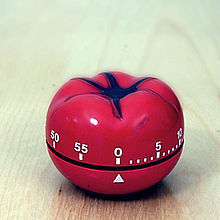
I'm not going to tell you what it does. But be afraid, be very afraid: it ticks! What I can tell you is that since the weekend it has become the weapon of choice for SAS members. I have received many enthusiastic, even evangelical reports on its efficacy.
There were murmurings about "Lakeland" which were obviously designed to confuse the enemy; it's an operational pseudonym for a whole heap of tactics.
There was also considerable mention of "Tickle" which must be another such code word.
One of the Balaclava brigade was clearly on a recruiting mission - let's call her the WP operative. There was mention of large sums of money available to those willing to adopt "tight briefs." Now, that sounded rather uncomfortable to me but several members seemed interested.
By the time balaclavas had been re-donned, plans were already being hatched for next year's conference. Operatives CJ and PL will be in charge. I can't wait.
Published on February 28, 2012 01:01
February 19, 2012
Feminism and the Shrew
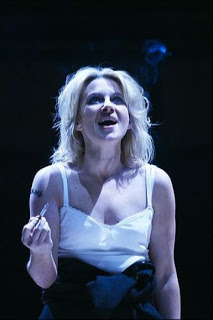 Yesterday afternoon, I saw a most enjoyable production of The Taming of the Shrew at the main house in Stratford. Here is the amazing Lisa Dillon as Katherine, leaving Cranford's Mary Smith far behind her as she drinks, smokes and even urinates on stage! (Really? or was it a different kind of bladder, a prop).
Yesterday afternoon, I saw a most enjoyable production of The Taming of the Shrew at the main house in Stratford. Here is the amazing Lisa Dillon as Katherine, leaving Cranford's Mary Smith far behind her as she drinks, smokes and even urinates on stage! (Really? or was it a different kind of bladder, a prop).But I can almost hear a sharp intake of breath from the Sisters, not to mention my daughters. How COULD you enjoy a play about the subjugation through deprivation and humiliation of a strong-minded woman?
I ask myself the same question.
Firstly, this is a fine, energetic production that defies carping. As well as Dillon, there is an actor I didn't know - David Caves - as a sexy, muscular, charismatic Petruchio, striding round the aptly-named thrust stage as a convincing Alpha male.
(It was a tad disconcerting that he and his servant Grumio - not to be confused with Bianca's suitor Gremio - were both Irish, especially since Petruchio mentions frequently that he is from Verona. A little known colony in the 1940s in Italy, where this production is set? Ah well, what the hell? They're both Catholic countries, aren't they, as the programme points out?)
Secondly, this is Shakespeare and it never does to underrate him. The play raises many questions and sets up an interesting scenario. An intelligent, opinionated woman is constantly unfavourably compared to her bland, simpering, younger sister by her father and others. She becomes not just wayward but wild with frustration and spite. Into this mix is thrown a man unlike all the others in Padua, someone completely unfazed by Kate's tricks.
She would certainly be intrigued and she is. His treatment of her - not the "rough wooing" but the with-holding of food and sleep, the insistence that she agree with him even when he says black is white - or in this case the sun is the moon - is all part of a game which she comes to understand and outwit him at.
Where it all falls down is that, having convinced him of her submissiveness, she should poison his pasta or slip a stiletto between his ribs, but by then she has discovered she is sexually attracted to him. Hmn, is this battered wife syndrome? No, it's a comedy. They all end in marriage and Caterina and Petruchio are as subject to the life force as any Shavian characters. When you look at the best Padua and Pisa have to offer - Gremio, Lucentio, Hortensio - drips, fops, old men, Petruchio at least begins to look like an interesting husband, especially once you've twigged what he was doing in his "courtship" and behaviour as a groom.
Of course it helps to convince when he looks like David Caves!
But Shakespeare never does this again (any more than he again uses confusing names like Gremio and Grumio in the same play). It was possibly his first or at any rate his second. And he is retelling, as he would so often later, from a given source; he didn't invent the plot. That goes back to Ariosto and beyond.
And yet ... as with the going one step further in making Shylock convert to Christianity, he gives Kate that wonderful, terrible speech at the end of the play.
No, after all I can't be comfortable with The Taming of the Shrew. But you won't see a finer production of it and it is worth it as a curiosity. Though I see the Globe is doing it this year too.
The stage at the RSC appears as a vast double-bed - Emperor-size you might say - which accommodates Christopher Sly in the framing device and various bedfellows. There's an article about Elizabethan beds in the programme and Director Lucy Bailey took the cast to see Shakespeare's bed in Stratford.
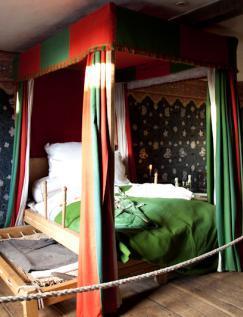
That underlines the point about the play's insistence on sex and the life force, as does the hilarious vignettes seen through opening doors and windows, like a saucy Advent calendar, of Bianca and Lucentio getting it on.
Published on February 19, 2012 12:00
February 10, 2012
A visit from Rhianna Pendragon
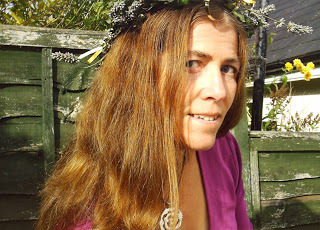 Book Maven is hosting a very special guest today. Katherine Roberts never ceases to surprise me and she has done it again today! She looks like everyone's idea of a fantasy author - long loose hair, long floaty skirts and dresses, interesting hats and jewellery - but believe me, this writer has a core of steel.
Book Maven is hosting a very special guest today. Katherine Roberts never ceases to surprise me and she has done it again today! She looks like everyone's idea of a fantasy author - long loose hair, long floaty skirts and dresses, interesting hats and jewellery - but believe me, this writer has a core of steel.She thinks nothing of writing 150,000 of a novel before getting a commission and is one of the most disciplined and determined writers I know. She also wrote I am the Great Horse, one of my all time favourite YA novels, so when I heard Katherine was venturing into Arthurian territory, I knew readers were in for a treat.
Sir Thomas Malory's Morte d'Arthur is probably my desert island book; I have several editions and have read it many times, since discovering it at university. My Medieval tutor once set me an essay title: 'Malory, the least intelligent author ever to become an English classic.' That was Cambridge in the 60s for you - utter codswallop. (I don't think I used that phrase in my essay).
Sword of Light is out this week and I was naturally very happy to join in Katherine's (and Rhianna's) blog tour. But I didn't expect she'd plunge back into one of my books to make her points.
Read and enjoy!
Katherine Roberts won the Branford Boase Award for her first children's novel "Song Quest" (reissued this month by Catnip Books). She is the author of the Seven Fabulous Wonders series (now available as ebooks for Kindle), and the Alexander the Great novel "I am the Great Horse".
With apologies to Malory… Sword of Light by Katherine Roberts
When the lovely Book Maven heard I was writing a series about King Arthur's daughter, she kindly sent me one of her own Arthurian books – the beautifully illustrated "Women of Camelot", which faithfully retells the stories of Arthur's women from Sir Thomas Malory's "Morte D'Arthur".
Since my heroine Rhianna Pendragon is not mentioned in these stories, I thought it might be fun to send her through the mists on her enchanted horse to Malory's Camelot, and see what the ladies of legend make of her.
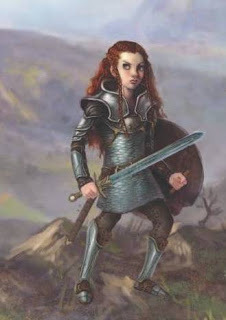 Rhianna Pendragon
Rhianna Pendragon
Igraine (Arthur's mother)
Oh, a darling little granddaughter! I'm so pleased Guinevere has finally given my son a baby… to think we all believed her childless, when all the time her little girl was hidden away in Avalon with Lord Avallach and his wild fairies. I don't care if she's a girl rather than a boy as everyone hoped. She'll make someone a lovely queen one day.
Guinevere (Arthur's wife)
I didn't have much choice. Merlin took my baby away when she was only a few days old, to keep her safe. He said if I didn't let him take her through the mists to Avalon, that witch Morgan would kill her… better if she had. Now I can hardly recognise the child! She's grown up wild. Worse, she's got a fairy boy sniffing around – Elphin of the violet eyes – a totally unsuitable suitor for a princess of Camelot. We are going to have to have a serious mother-and-daughter chat very soon. I think there are going to be tears…
Morgan (le Fay)
Your own tears, probably, foolish woman! Thought you and Merlin could hide Arthur's daughter from me, did you? I can see through the mists between worlds, so I knew all along where she was… I just couldn't touch her, until Mordred killed Arthur and we lured her out of Avalon. Now she's here in the land of men, and no fancy Avalonian armour or magic sword will keep her safe from ME! The throne of Camelot belongs to Prince Mordred. All other threats to the succession must be removed.
Nimue (Lady of the Lake)
I must say it was a surprise when she turned up at my lake on her fairy horse, demanding I give her Excalibur. I'd expected a boy. I wasn't going to give her the sword at first, but then she swam down into my underwater cave to take it off me! Not even Arthur dared do that. So I thought, why not give the girl a chance? I doubt she'll complete her quest to bring Arthur back from the dead, since she hasn't discovered the answers to all my riddles yet. The one about the Grail always gets them. But she's certainly brave.
Lyonet (the Savage Damsel)
A girl after my own heart! I'll train her to use that sword if Arthur's knights don't. More girls should learn to fight and stand up for themselves in this world. Then maybe evil men would stop imprisoning us in towers, and we wouldn't have to be rescued all the time. Go, Rhianna Pendragon!
Morgause (Morgan's sister, Mordred's mother)
Huh! I'm going to be Queen Mother at Camelot soon if things go to plan, and the girl claims she's never even heard of me! I was the one who slept with my silly half brother to sire that ungrateful little bastard Mordred so my sisters and I could sit him on the throne after Arthur's death… yet apparently in her world, Morgan's claimed all the credit, and Elaine and I don't even exist! What did I do wrong?
Rhianna Pendragon (King Arthur's daughter)
I've enjoyed meeting you all, but I'm afraid I can't stop for dinner. I might have got the Sword of Light back from Nimue, but I've still got to find the Lance of Truth, the Crown of Dreams, and the Grail of Stars… and deal with my cousin Mordred, of course. Keep the throne warm for me. See you soon.
The Pendragon Legacy quartet about King Arthur's daughter is published by Templar with the first book SWORD OF LIGHT now available in hardcover
Katherine's website is at www.katherineroberts.co.uk and you can follow Rhianna Pendragon on Twitter at www.twitter.com/PendragonGirl
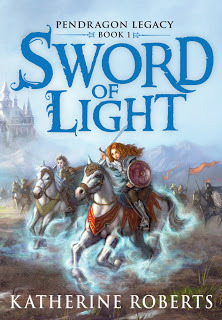
Published on February 10, 2012 01:01
February 2, 2012
Vultures of Venice and other Coincidences by Michelle Lovric
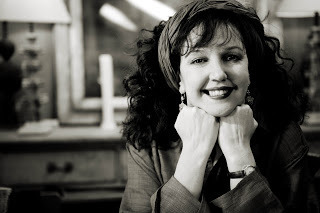 Photo by Marianne TaylorMichelle Lovric is my guest today as part of her blog tour for Talina in the Tower, her third children's book for Orion. And I'm very honoured because today is actually her publication day!
Photo by Marianne TaylorMichelle Lovric is my guest today as part of her blog tour for Talina in the Tower, her third children's book for Orion. And I'm very honoured because today is actually her publication day!Michelle Lovric is a very versatile writer of novels for adults and children. She has particular interests in art, the history of medicine and Venice, where she lives part of the time and where all her novels are at least partially set. Her most recent novel for adults, The Book of Human Skin, featured on the 2011 TV Book Club. Talina in the Tower is her third novel for children, and she's currently at work on her fourth, The Fate-in-the-Box. She is currently a Royal Literary Fund Fellow at the Courtauld Institute of Art. For more information, see her website: www.michellelovric.com
Over to Michelle:
This is what I saw on the Palazzo Grassi, the day I handed in the manuscript of Talina in the Tower, a novel that features a greedy vulture called Restaurant, who lives in his 'stake house' on a remote island in the Venetian lagoon. The stakes are what he uses to impale his victims, so that he may dine on them at leisure.
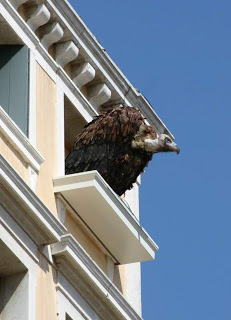
The vulture on the Palazzo Grassi, real as it looks, is not a live projection of my deadline-damaged imagination. It is, in fact, 'art', created by Sun Yuan and Peng Yu, leaders of the contemporary Chinese art scene, who create sculptures and installations using a variety of unconventional materials such as cadavers, human fat tissues and waste material. According to the Palazzo Grassi website, 'a perennial obsession with death in their work is blended with a macabre comic appeal'. About the vulture, the site explains, 'This menacing animal humorously embodies the cruelty of the modern world: we become the carrion-eater's potential prey – an unpleasant position, as vultures typically devour the wounded, the sick, or the remains of animals killed and eaten by other predators.'
Yes, I thought, looking at the vulture, my Restaurant is all that – thank you! The vulture is not the only coincidence to befall me in writing Talina in the Tower. The villains in the book are strange wolf-like creatures who seem to be French, seem to be magical and seem to have mysterious rights over the city of Venice. I coined the name Ravageurs for them because they ravage everything they come across and feel themselves entitled. Checking the name on the internet, I found that it was the name given to a small French parasite that preys on vines. That seemed entirely suitable. But more recently I discovered on the internet a perfume called Musc Ravageur, by Editions Parfums Frederic Malle. Poste-haste went I to Liberty's to smell its tangy, vivid aroma, redolent of amber, lavender, bergamot, clove, cinnamon, Gaiac wood, cedar, sandalwood, tonka and musk. (My Ravageurs smell of raw rotten meat, unfortunately.)
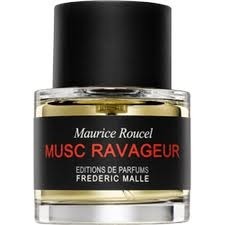
Katie Puckrik, an eloquent perfume reviewer on YouTube explains how Musc Ravageur is legendary as a 'man-catcher' and 'bird-snatcher': it makes men come on all wolfish but has women feeling 'Hello Kitty'. From my own sniffs, I agree with her that it has a 'soft warm monkey business vibe' infused with a 'delicious animalic muskiness'. Nevertheless, at £90 a bottle, it was a bit expensive as a writer's self-gift. So I contented myself with a deep sniff and a little tranche of impregnated cardboard for the Talina research file.
The coincidences keep coming, and some are retrospective. Some recent discoveries have conferred historical veracity on aspects of a story I happily invented in The Undrowned Child. In that novel, the blind warrior Enrico Dandolo comes to life again in 1899 to help save Venice from my villain, Bajamonte Tiepolo. Now I have found out, researching something completely different, that there was indeed an old and deep hatred between the Dandolo and the Tiepolo families in Venice. Of course Dandolo would have wanted to kill Bajamonte. Another newly-discovered fact … it was Enrico Dandolo who sent Saint Lucy's body back to Venice, having captured it in Constantinople. In The Undrowned Child, Dandolo goes to San Geremia to make sure her body has been revived for the apocalyptic final battle. Yet I had no idea of the very personal connection between warrior and saint when I wrote that scene.
The strangest coincidences always bind me to the incomparable Wellcome Collection. I am working on my fourth children's book at the moment. It has a deadline as terrifying as anything I could invent. The Fate-in-the-Box is historical fantasy, and so mostly being manufactured in my head, though always set in Venice, of course.
Anyway, in a Venetian text, last year, I came across some information about seahorses and good luck in Venice: the Venetians used to carry little glass ones as talismans. Then, to my delight, I discovered that Venice's newly reopened Natural History Museum features a lovely tank with live seahorses from the lagoon. So the glass seahorses as talismans were already in The Fate-in-the-Box, from the very first scene, as it happens. But I had never seen one of the old talismans in any of the Venetian museums, and didn't really think I had much hope of doing so, given how fragile they are.
So imagine my pleasure when I entered the 'Miracles and Charms' exhibition at the Wellcome, and galloped straight to a collection of amulets and talismans made by early twentieth-century folklorist, Edward Lovett. One metre into the exhibition, I saw that Lovett had been in Venice, hunting amulets. Discovering the story of the Venetian seahorse good-luck charms, he had commissioned some glass reproductions to be made for his collection. And there they were at the Wellcome in London, among four hundred of Lovett's amulets, choreographed (the only word to express the grace of her work) by the artist Felicity Powell: 'my' glass seahorses dancing in a wave of coins, rabbit feet, carved shells and even a gondola ferro.
Bizarre but in a nice way. Like so much to do with writing children's fiction.
Miracles & Charms at the Wellcome ends on February 26th. Don't miss it.
Venice's Natural History Museum website
Musc Ravageur fragrance review
Michelle Lovric's website
Talina in the Tower, is published on February 2nd 2012 by Orion Children's Books
We have three copies to give away to the first three people to answer this question:
'Why do none of Michelle Lovric's characters use bicycles?'

Published on February 02, 2012 01:01
February 1, 2012
Tomorrow is Candlemas

February 2nd, Presentation of Jesus in the Temple, and three good things happening for Book Maven! She and her friends all have books coming out - what is it about publishers and February second? Maybe the Presentation of Books in the Market has a sort of Biblical ring to it?
Book Maven wrote last week about the mass market paperback of David (Bloomsbury) but there is also Celia Rees's This is not Forgiveness (also Bloomsbury). Celia will be guesting on the blog next month.
We could have only one guest on February 2nd and it's Michelle Lovric, talking about her new novel Talina in the Tower (Orion). There's also a competition to win a copy. Don't miss it!
And Happy Candlemas!
Published on February 01, 2012 01:01
January 28, 2012
Attractive teen heroes
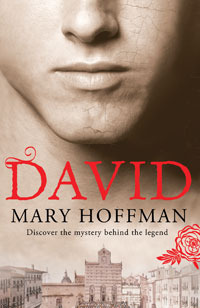 (I am actually on a plane to Denver today so have scheduled this post in advance - on 2nd February Michelle Lovric will be my guest here on the publication day of her Talina in the Tower)
(I am actually on a plane to Denver today so have scheduled this post in advance - on 2nd February Michelle Lovric will be my guest here on the publication day of her Talina in the Tower)This post is inspired by the publication (2nd February in the UK) of the mass market paperback of my novel, David - only £6.99 full price. It's about the young man who posed for Michelangelo's iconic statue in Florence. Nothing is known about the model, or even if there was one, so I have invented him! Obviously he has to be spectacularly beautiful, so Gabriele is. But he must also appeal to the reader, which got me musing on what teenagers, especially female ones, find appealing in a hero.
I remember my English teacher at school being very fed up with my tutor group because we liked the "wrong" characters in our set books – Hal rather than Hotspur in Henry lV Part One and Edmund in preference to Edgar in King Lear, for example.
We seemed to prefer villains to heroes and shady characters to upright ones. Perhaps we were Emos before our time?
But isn't that bad boy image what attracted women readers to Heathcliff and Mr Rochester? (It didn't quite work for me because once I discovered Heathcliff had hanged Isabella's dog, I went right off him).
I had a couple of older sisters so I was reading their library books when I was still pre-teen – authors no-one reads now, like Mazo de la Roche and Ursula Bloom. But the ones I did pick up and remember were novels by Dorothy Sayers and Georgette Heyer.
Lord Peter Wimsey would surely not appeal to many teenage girls today, with his monocle and his flaxen hair like Andrew Aguecheek's, all smoothed down – probably with brilliantine – and his vacant aristocratic manner?
But it was all a front, you see for a brilliant mind and when he fell in love with Harriet Vane, he said incredibly sexy-sounding things to her in French, like "tu m'enivres." (I knew the text of Busman's Honeymoon by heart I had read it so often).
And in Georgette Heyer's Devils' Cub I found the hero of my dreams, the dark and dashing Dominic, Marquis de Vidal. I loved that book so much that as soon as I finished it I had to start reading it all over again, because I could not bear to leave its world.
Later, when I discovered Jane Austen at school I much preferred Mr Knightley to Mr Darcy, Henry Tilney to Edward Ferrars – I liked the men who kept their women from the excesses of their own foolishness, who were strong and kind but capable of issuing a good telling-off.
I suppose if there had been literature aimed at teenage girls in my youth, as there is in abundance today, I might have fallen for the sexy vampires and devoted werewolves, the broken angels and redeemable demons. But I was spared them.
In recent online surveys about crushes in YA fiction, the two Twilight Alpha males, Edward and Jacob, vampire and werewolf respectively come out top but with Peeta from The Hunger Ganes giving them a good run. And there are many fans of the Harry Potter characters, especially the Weasley brothers and even Draco Malfoy (though his father Lucius has almost as many fans). I think these choices must be influenced by casting in the films – those marmalade-cat twins and Jason Isaacs. But I can't take them seriously as crushes myself.
My teen heroes were all in adult books when I was a teen myself but now that I read and review a lot of Young Adult (YA) Fiction and write it too, I have developed a sophisticated taste in hot young men all over again,
Not for me the ones whose rippling six packs are described in loving detail by their over-heated authors (always female) who are as smitten by their own heroes as ever plain and dumpy Dorothy Sayers was bowled over by her pale blond Lord Peter.
(My own most-admired creation of Lucien/Luciano in Stravaganza is hardly described physically at all. He has dark curly hair and a nice smile; that's about it. Yet fourteen-year-old girls love him.)
I think I still like them a bit angsty and tortured; I don't even mind if they look a bit girly, as long as they are strong-minded. (Always preferred Geeks to Jocks).
So here's my list of the hottest heroes in books read by teens, whether intended for them or not (in no particular order):
1. Howl in Diana Wynne Jones's Howl's Moving Castle. Conceited, petulant, arrogant, immature, Howl nevertheless steals every scene he appears in. It helps that he's a wizard and that the sorely-missed Diana Wynne Jones was something of a witch, making wickedly funny scenes out of Howl's many discomfitures at the hands of heroine Sophie.
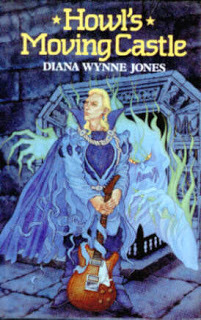
2. Per Sterkarm in The Sterkarm Handshake by Susan Price. It's pronounced "stark-arm" and is the name of a family of 16th century border bandits. Per is the only and most beloved son, whose pretty face gets him the nickname of "the May" or maid. But he's a useful man in a battle, a lusty lover and one who inspires devotion in everyone from his father, to his hounds, to the 21st century time-traveller Andrea.
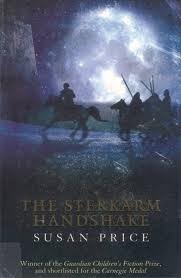
3. Seth McGregor in Firebrand and its sequels by Gillian Philip. If I tell you Seth is a fairy, don't run away with the wrong idea. He is one of the Sithe, both a sixteen-year-old and someone who has lived four or five hundred years. Sexy, violent and devoted to his half-brother, Seth is hero to make the heart beat faster – or to break it.
4. MCC Berkshire is the extraordinary hero of Geraldine McCaughrean's extraordinary A Pack of Lies. It won the Carnegie Medal and the Guardian Children's Fiction Prize over twenty years ago. MCC has a passion for cricket, second-hand books and is a mesmerising storyteller. My kind of guy. He gets under the skin of Ailsa Povey but what happens in the end is much too good to give away.
5. Sorensen Carlisle in The Changeover by Margaret Mahy. One of my all time favourite YA novels, it's subtitled "a supernatural romance" – and it came out in 1984! Sorensen (Sorry, as the heroine, Laura Chant calls him) is a witch, living with his mother and grandmother. He wears a black caftan at home and antique rings and has silver eyes. Eat your heart out Edward Cullen!
6. Aragorn in Tolkien's Lord of the Rings. Long before Viggo Mortensen did his turn for Peter Jackson as the stubbly ranger who was a king in waiting, he was my hero. He had all those names, for one thing – Strider, Elessar Elfstone and so on. It was a bit of a shock to discover he was eighty-six; I don't think my teenage crush quite recovered from that. But there was always Legolas (though he was seven thousand years old) and Elrond in the elf department and lovely Faramir, the human hero.
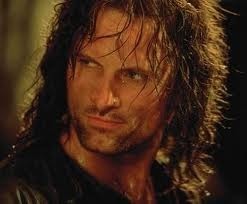
7. Icarus Ocean Tompkins in Annie Dalton's Out of the Ordinary. A flute-playing busker with a beautiful but "unreliable" smile. He got his names from his parents in their hippy phase. We don't meet him till about 80 pages in but from then on he helps Molly Gurney save her mute foster brother from an evil Magus.
8. Fox (David Stone) in Exodus, Zenith and Aurora by Julie Bertagna. In a drowned world of the future, Fox is the rebel grandson of the man who has founded the city of New Mungo. We don't know a great deal about what he looks like but he's the Han Solo and Luke Skywalker of his world rolled into one and his love story with the heroine Mara Bell, is more than poignant.
9. Leonidas in Halo by Zizou Corder. OK, he's a Spartan at the time of Pericles, so not the most up to date of heroes and he practises the cruel military arts he's been taught in the Spartan army. But he keeps saving Halo's life and eventually she saves his. What could be more romantic?
10. Alistair Windlass in Castle of Shadows and City of Thieves by Ellen Renner. This one shouldn't be an attractive hero at all. For a start, he's not a teenager but one of the adults – he is Prime Minister even! And morally, he's as suspect as Zaphod Beeblebrox, calculating and sinister. BUT there is something very beguiling about him.
So how about you? Tell me your favourite YA attractive heroes and maybe we'll get enough suggestions for a poll!
Published on January 28, 2012 01:01
January 21, 2012
Re-telling
I've been busy preparing PowerPoints for my trip to Denver in a week's time and one of the talks I'm giving at the teachers' conference for the Colorado Council of the International Reading Association (CCIRA) is about picture books and retellings. I discovered I'd written and published 24 of the former (one of them a re-telling) and 14 of the latter (not counting the one that's a picture book).
Here are some of them:
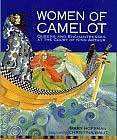 The stories of King Arthur told from the point of view of the women: Guinevere, Igrayne, the Lady of the Lake, Morgan and so on. I loved writing this. The stylish pictures are by Christina Balit and it was published by Frances Lincoln.
The stories of King Arthur told from the point of view of the women: Guinevere, Igrayne, the Lady of the Lake, Morgan and so on. I loved writing this. The stylish pictures are by Christina Balit and it was published by Frances Lincoln.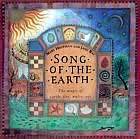 This was the first of two collections of myths and legends from all round the world, illustrated by my friend Jane Ray and published by Orion. The other was Sun, Moon and Stars and they were both gorgeous books to work on. Jane and I had several meetings where we made heaps of ideas, images, stories, cuttings and then I had a first stab at the text and Jane came up with her stunning pictures. Then we modified the text for any changes the artwork had suggested might be improvements. This one won a prize: The Primary English Award.
This was the first of two collections of myths and legends from all round the world, illustrated by my friend Jane Ray and published by Orion. The other was Sun, Moon and Stars and they were both gorgeous books to work on. Jane and I had several meetings where we made heaps of ideas, images, stories, cuttings and then I had a first stab at the text and Jane came up with her stunning pictures. Then we modified the text for any changes the artwork had suggested might be improvements. This one won a prize: The Primary English Award.This was a Frances Lincoln book too, a collection of animal stories from around
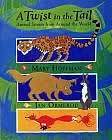 the world. The fabulous illustrations were by Jan Ormerod. I hadn't seen her animal paintings before we started the collaboration and was blown away by her lions and tigers, her pelican and gold and pink fish and her mud-spattered Native American hero and his pony.
the world. The fabulous illustrations were by Jan Ormerod. I hadn't seen her animal paintings before we started the collaboration and was blown away by her lions and tigers, her pelican and gold and pink fish and her mud-spattered Native American hero and his pony.It's always a thrill when the artwork comes in on an illustrated book and especially when it's a re-telling, because you are both re-interpreting a story that preferably is already known to you.
 Though when I met Julie Downing, the American artist for A First Bible Story Book (Dorling Kindersley) she told me that the stories were all new to her, apart from the very well-known ones, like Adam and Eve and Noah's Ark. And that's a very good reason for re-telling any story, if it's fading from general knowledge. (After I met Julie in San Francisco, she told a friend "I had coffee with the person who wrote the Bible - and it was a woman!")
Though when I met Julie Downing, the American artist for A First Bible Story Book (Dorling Kindersley) she told me that the stories were all new to her, apart from the very well-known ones, like Adam and Eve and Noah's Ark. And that's a very good reason for re-telling any story, if it's fading from general knowledge. (After I met Julie in San Francisco, she told a friend "I had coffee with the person who wrote the Bible - and it was a woman!")So how do you re-tell a story as well known as Cinderella? I've done it twice.
The first was in this Dorling Kindersley collection of Fairy Tales, illustrated
by Julie again. I had very few words, because it had such a lot of pictures
and the typeface was large. But it covered all the basic elements and got the job done.
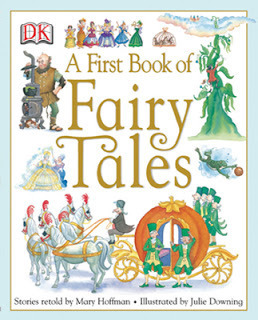
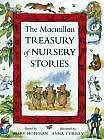
The second version, written almost in parallel, for the Macmillan Treasury of Nursery Stories, gave me far longer to expand on how nasty the sisters were and how magical the transformations wrought by the Fairy Godmother. The delightful pictures were by Anna Currey, whom I met for the first time only last month, years after we did the book.
So what shall I tell my audience about re-tellings next week? I isolated four vital components of a re-telling:
• First, and perhaps, most important, you must actually LIKE the stories you are re-interpreting for a new generation of readers.
• Second, you can't change the basic plot. Cinderella has to marry the Prince. If she doesn't, that's not a re-telling but a whole different ball-game (in which I am also interested!)
• Third, while keeping the basic plot, the re-teller needs also to re-imagine the story, so it sounds as if they've just made it up.
• Fourth, give your sources. It might not matter to the child reader/listener but it shows you have gone back to the original and any interested adult will be able to see what you have added or taken away.
Just last week I was asked to do another re-telling. It isn't definite yet, but it's a story I have always loved and there is a set of illustrations already waiting. But I won't be writing glorified captions; I will be putting myself into it, giving it a few touches that can make it my own. And yes, I've already re-told it a couple of times!
Published on January 21, 2012 16:19
Mary Hoffman's Blog
- Mary Hoffman's profile
- 591 followers
Mary Hoffman isn't a Goodreads Author
(yet),
but they
do have a blog,
so here are some recent posts imported from
their feed.



